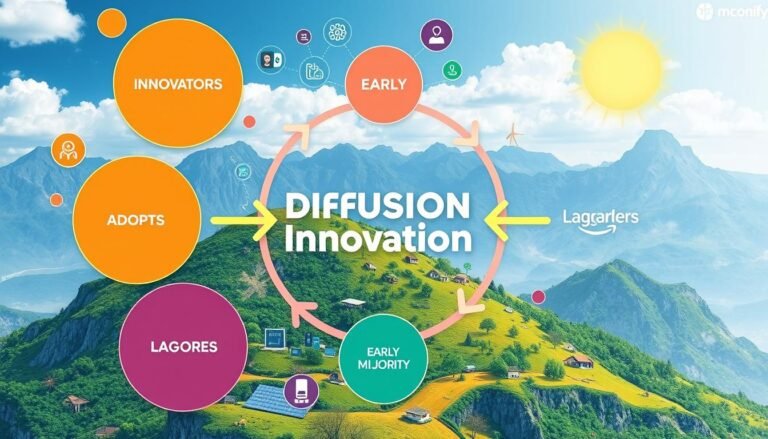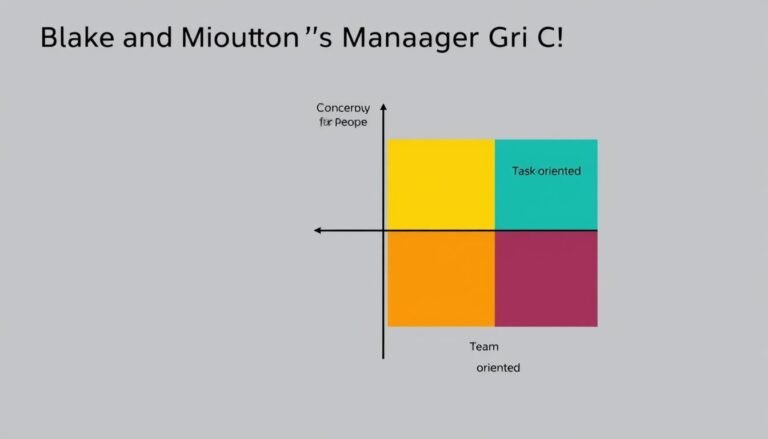Exploring the Impact of Design Thinking on Innovation
Have you ever thought about why some companies innovate easily while others find it hard? It might be because of their problem-solving approach. Design Thinking, based on putting people first, is becoming key in many industries. This method makes users more engaged and helps companies meet real user needs better. Let’s look into how this creative process can change how companies face challenges and spark innovation.
Key Takeaways
- Design Thinking combines creativity and analysis to boost innovation.
- It focuses on understanding what users need through a detailed process.
- Big consulting firms are investing in design consultancies, showing its importance.
- This approach helps companies shift from focusing on problems to finding solutions.
- Creating hypotheses is a key part of Design Thinking, allowing for exploring possible solutions.
Understanding Design Thinking and Its Principles
Design Thinking puts people first in solving problems. It helps companies understand their users by looking into their lives, struggles, and dreams. This way, businesses can make products that really connect with people. Design Thinking is all about making things that are wanted, possible, and can work in the real world.
Human-Centered Approach to Problem Solving
Starting with empathy is key in human-centered design. It means understanding how users feel and think. Companies like Google and Apple use this method to make sure their products meet what users want and need. By listening to user feedback, companies can make their solutions better and more effective.
Desirability, Feasibility, and Viability in Innovation
Design Thinking combines desirability, feasibility, and viability for innovation. Desirability checks if people want the solution. Feasibility looks at if it can be made. Viability checks if it can make money. This way, companies can make sure their ideas are good, doable, and can succeed in the market.
The Phases of the Design Thinking Process
The Design Thinking process is a structured way to solve complex problems creatively. It focuses on understanding users and has several phases. These phases help teams move from understanding problems to testing solutions. The five-phase model from the Hasso Plattner Institute of Design at Stanford is key for innovation.
Defining the Problem Statement
Defining the problem statement is crucial. Teams describe the challenge in a way that focuses on people. This step sets the project’s direction, making sure everyone knows what they’re working towards. A clear problem statement helps the team create solutions that really meet user needs.
Gathering Inspiration and User Insights
Gathering user insights is vital in this phase. Methods like interviews and observing users reveal what they like and do. By really understanding users, teams can make solutions that connect with them more deeply.
Building Prototypes for Testing Solutions
Building prototypes is a key step in making ideas real. These are smaller versions of solutions that can be tested and improved. Prototyping helps check if ideas work and makes it easier to refine designs. This approach lets teams test and improve their ideas safely.
The Role of User Empathy in Driving Innovation
User empathy is key in the design thinking process. It helps companies innovate better. By building emotional connections with users, companies can make solutions that hit home. This comes from doing research that really gets into what users need and what frustrates them.
Switching focus to real user experiences often leads to new and friendly solutions.
Connecting with User Needs through Research Techniques
Good research is crucial for knowing what users need. Immersive empathy and watching users closely are big parts of this. Companies like IDEO have used these methods to make hospitals better for patients, focusing on what patients need.
They also came up with the Embrace Global Infant Warmer. This low-cost incubator has saved thousands of lives in tough situations.
Impact on User Experience Design
User empathy changes how we design for users. For example, Airbnb’s success comes from caring about users’ feelings and building trust. Microsoft’s Xbox Adaptive Controller shows how empathy can lead to innovation for people with special needs.
In teams, exercises in design thinking workshops at IBM boost innovation and respect. A focus on empathetic design often leads to real solutions that meet users’ true needs. This is shown by Google Glass’s failure, which was all about tech for tech’s sake.
| Company | Empathetic Approach | Outcome |
|---|---|---|
| IDEO | Redesigned patient experience | Patient-centered solutions |
| Embrace | Developed Global Infant Warmer | Low-cost incubator saving lives |
| Airbnb | Emotional connections with users | Building a trusted brand |
| Microsoft | Inclusive design for accessibility | Xbox Adaptive Controller |
| IBM | Empathy exercises in workshops | Enhanced collaboration and innovation |
| Lacked empathy in design | Product failure |
Putting a big focus on user empathy really improves the design for users. It leads to solutions that meet both their needs and their feelings.
Design Thinking as an Innovation Methodology
Design thinking is a key way to innovate, moving from focusing on problems to finding solutions. This shift helps teams find creative answers to tough challenges. By turning problems into chances for new ideas, companies can use their full potential to solve problems.
Transitioning from Problem-Focused to Solution-Focused Thinking
Design thinking changes how teams see things. It makes them focus on what users need, valuing empathy and connection. This way, people think more about what’s possible, not just the problems.
Working together, teams can come up with new strategies that work. This teamwork leads to real innovation.
Iterative Design: Learning from Feedback
Design thinking is all about improving through feedback. Teams test their ideas with people to make them better. This way of learning is key for new ideas to grow.
Companies that use this method don’t just get better solutions. They also stay ahead in a fast-changing market.
| Aspect | Problem-Focused Approach | Solution-Focused Approach |
|---|---|---|
| Mindset | Defensive and reactive | Proactive and optimistic |
| Focus | Identifying problems | Exploring possibilities |
| Process | Linear steps | Iterative cycles of feedback |
| Outcome | Short-lived solutions | Sustainable innovations |
Using this approach, companies can tackle big challenges well. By adding iterative design, they create a space for new ideas to grow. Design thinking is key for companies that want to keep innovating.
Case Studies: Successful Implementation of Design Thinking
Many companies have used Design Thinking to bring new ideas to life. This method puts the focus on what users really need and makes solutions for them. We see big changes in different fields thanks to this approach.
Notable Companies Using Design Thinking
Big names show how Design Thinking leads to amazing results:
- Airbnb connects travelers with unique places by really listening to what users want, making sure both guests and hosts are happy.
- Apple uses Design Thinking to make products like the iPhone better, by testing and improving them step by step.
- Netflix changed the way we watch shows by making it personal, thanks to deep understanding of what users like.
- UberEats changed food delivery with Design Thinking, making services that work for both customers and restaurants.
Transformational Outcomes in Different Industries
Design Thinking does more than just improve products. It brings big changes across many areas:
- Société Générale Global Solution Centre cut down on invoice processing time and boosted team work by using Design Thinking.
- Oral B listened to what users didn’t like about electric toothbrushes and made them better, making customers happier.
- OTP Bank Romania aimed to double its market share in five years and did it by working closely with customers.
- Scania IT showed how a company’s culture can help in being more innovative, thanks to Design Thinking.
| Company | Industry | Transformational Outcome |
|---|---|---|
| Airbnb | Travel & Hospitality | Enhanced user connection and engagement. |
| Apple | Technology | Iconic product development through user-centric design. |
| Netflix | Entertainment | Personalized content based on user insights. |
| UberEats | Food Delivery | Streamlined services for improved customer experiences. |
These stories show how Design Thinking changes things in many fields. It helps bring new ideas to life and makes products that really meet what users want.
Challenges in Adopting Design Thinking Practices
Bringing Design Thinking into an organization can be tough due to the current culture. Many people resist new ideas, especially if they question old habits. Not knowing about Design Thinking also adds to the challenge. Over half of remote team members say working from home makes it hard to work together, which can slow down innovation.
Overcoming Resistance in Organizational Culture
The culture of a team greatly impacts how well Design Thinking works. Teams that skip the empathy part often can’t find real solutions to problems. This leads to poor problem-solving. Also, many feel left out from their company and colleagues when working remotely, making it hard to work together in Design Thinking.
Design Thinking is all about solving problems in new ways. It lets teams try out different solutions without sticking to one plan. This can spark new ideas but might be hard for those used to traditional methods. Teams may struggle to move on from ideas that don’t work out.
The EY report “Demystifying design thinking: becoming part of the movement” says that embracing Design Thinking is key. But, it’s not easy. Different views on how to use it have led to mixed results.
| Challenge | Description |
|---|---|
| Resistance to Change | Employees may resist adopting new practices due to entrenched cultural norms. |
| Remote Work Isolation | Communication barriers in remote settings hinder collaboration essential for Design Thinking. |
| Neglecting Empathy | Skipping the empathy stage leads to a disconnect between user needs and proposed solutions. |
| Cultural Mismatches | Centralized cultures often conflict with the decentralized approach needed for innovation. |
| Time Constraints | Organizations may struggle to allocate adequate time for thorough Design Thinking practices. |
Conclusion
Design Thinking is a key way to boost Innovation by focusing on what users need. It starts with understanding people and ends with testing solutions. This makes sure the solutions really help customers and fit the company’s goals.
This method also helps in creating new ideas and making them work. By keeping users involved, companies learn more about what people want and need. This leads to products and services that really meet those needs.
In today’s fast-changing business world, using Design Thinking gives a big edge. Companies that use this approach can handle tough challenges and stay ahead. It’s all about working together, understanding others, and learning from each step. Design Thinking is key for any business wanting to improve its focus on users.
Source Links
- Exploring the impact of design thinking tool among design undergraduates: a study on creative skills and motivation to think creatively – International Journal of Technology and Design Education
- What is Design Thinking? — updated 2024
- Design thinking – Process and Principles
- The 5 Stages in the Design Thinking Process
- 5 Steps of the Design Thinking Process: A Step-by-Step Guide
- The Role of Empathy in Design Thinking
- This is Why Empathy Needs to Drive Design Thinking | City Innovations
- IDEO Design Thinking
- What Is Design Thinking & Why Is It Important? | HBS Online
- Explore 10 Great Design Thinking Case studies
- Explore: Design Thinking Case Studies
- 4 common challenges and pitfalls in design thinking | Mural
- The Challenges Posed By Design Thinking—And How To Overcome Them
- Why design thinking adoption fails. And what to do about it.
- Design Thinking – Conclusion
- The Five Phases of Design Thinking
- Design Thinking: Everything You Need to Know







